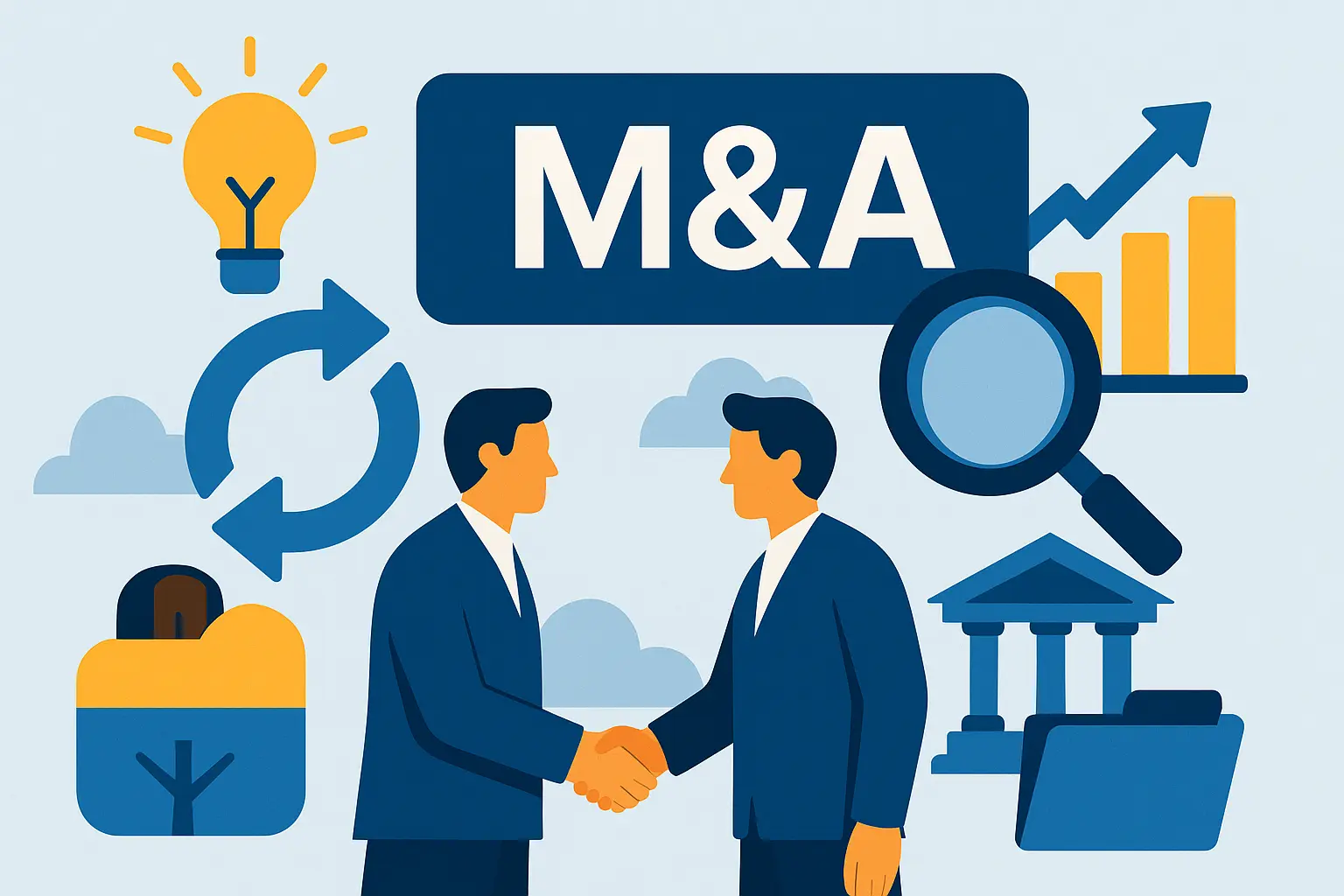Did you know that the average transaction value for the M&A market amounts to USD 732.09 million? Yes, M&A are powerful tools businesses around the globe use to:
- Grow
- Enter a new market
- Gain a competitive edge
Nonetheless, mergers and acquisitions deals aren’t just about two companies joining forces. That’s because acquisition strategies are evolving rapidly, supported by all, from AI-driven deal sourcing to strict ESG regulation requirements and increased geopolitical risk.
Here’s everything you need to know about effective M&A strategies and how they help businesses achieve their goals.
What is an M&A strategy?
A mergers and acquisitions strategy is a comprehensive plan that outlines how businesses can achieve market competitiveness, long-term growth, and value creation through strategic partnerships or M&A deals.
Hence, a strong business acquisition strategy emphasizes the following elements:
- Identify potential targets. The process begins with identifying and evaluating companies that align with your organization’s strategic objectives. Such objectives involve market expansion, acquiring innovative technologies, or creating operational synergies.
- Due diligence. Conducting thorough due diligence not only uncovers legal, operational, and financial risks but also supports informed decision-making.
- Valuation. It is a vital component of merger strategies, which involves assessing growth potential, market conditions, and financial performance to determine the fair price for the target company.
A good m&a strategy not only helps enhance the market reach of the business but also helps reduce the potential risks that can impact the M&A deal cycle.
Types of M&A strategies
Mergers and acquisitions strategies vary depending on the company’s objectives, market opportunities, and industry dynamics. Here’s a list of some of the M&A strategies.
1. Horizontal merger strategy
It is a type of strategy that involves acquiring or merging with a firm that is operating within the same industry, offering similar services or products. With a horizontal M&A strategy, businesses:
- Consolidate market share
- Achieve economies of scale
- Reduce competition
Hence, a horizontal merger strategy enhances overall production efficiency owing to the shared research and development, technologies, and marketing.
Nonetheless, horizontal merger strategy comes with cons too; here is how:
- Integration issues. Post-merger integration may turn out to be a failure due to managerial, cultural, and production challenges that not only delays success but also reduces market value.
- Regulatory challenges. There is a possibility of antitrust risk when two firms operating in the same industry merge.
Acquisition strategy example: The Walt Disney had acquired 21st Century Fox for $71 billion in March 2019, strengthening its position in the media industry by reducing overall competition and gaining a new customer base.
2. Vertical acquisition strategy
Vertical acquisition strategy takes place when an acquirer buys firms operating in the same industry but at different production stages. Thus, the target company could be a supplier or a distributor.
Hence, with an IT integration strategy for mergers and acquisitions, companies can benefit in the following ways:
- Increased revenue. When a business manages more parts of its supply chain operations, it can market and sell its products at optimum prices and strengthen its market position.
- Better cost control. By acquiring distribution channels and suppliers, businesses gain more control over both production as well as delivery, reducing dependence on third parties.
- Stronger operations. By merging with suppliers or distributors, companies have better control over technology and cost structuring, making overall business operations smooth and efficient.
However, the vertical merger strategy has the following drawbacks:
- Less flexibility. Once firms fully integrate their supply chain operations, they may find it difficult to adapt to market changes or new competitors.
- High costs. A vertical merger requires a high budget to bring together production, technology, and employees.
- Risk of losing talent. Layoffs or confusion from combining different systems may push the skilled workforce to leave.
Acquisition strategy example: Amazon acquired Whole Foods in 2017 for $13.7 billion, which gave the company better control over its grocery supply chain and distribution.
3. Concentric M&A strategy
Concentric M&Aa happen when firms within the same industry join forces together to offer more products and services. This approach targets companies with complementary products and services.
Thus, a strong brand strategy for mergers and acquisitions not only ensures consistent positioning but also preserves customers’ trust during integration. The strategy helps companies in the following ways:
- Reduced costs. Sharing production facilities, technology, and resources cuts down overall marketing, distribution, and manufacturing expenses.
- Diversification. The new company can offer more products and services, expanding into new categories.
- Growth opportunities. With new product categories, businesses attract a new customer base, driving long-term growth.
Although with concentric M&A deals, businesses can expand their production, since they operate in the same industry, they cannot add more diverse products, like in the case of conglomerate M&A.
Acquisition strategy example: Apple acquired Beats Electronics in 2014 for $3 billion, giving it a foothold in the premium audio market as it complements its existing products (iTunes and iPhone).
4. Conglomerate acquisition strategy
A conglomerate strategy involves companies from completely different industries or business activities. Hence, conglomerate acquisition assists businesses to:
- Increase revenue. With more products and a customer base, conglomerates access new revenue streams.
- Diversify business portfolio. Conglomerates acquire businesses in unrelated industries to spread risk and stabilize the economic downturn. If one company struggles, the other may outperform.
Nevertheless, conglomerate acquisitions pose certain issues, including:
- Managerial issues. Poor decisions like implementing a business model that doesn’t fit into the acquired business model not only slows down economic growth but also creates operational problems.
- Cultural differences. Since every company has its own culture, two companies from unrelated industries may experience integration challenges.
Acquisition strategy example. The acquisition of Nest Labs by Google for $ 3.2 billion is among the well-known examples of successful business strategies that helped the company expand into smart home technology.
5. Cross-border M&A strategy
Cross-border mergers and acquisitions strategy is becoming an integral part of corporate strategy M&A as businesses seek global expansion to:
- Access a new customer base
- Diversify the supply chain
- Leverage international expertise that enhances operational efficiency
Among the key M&A strategy trends for 2025, cross-border transactions are influenced by global regulations, digital integration, and a strong focus on sustainability.
Businesses are utilizing AI-powered analytical tools to identify global opportunities faster and manage the complexity that comes with high-stakes transactions.
Thus, companies need to manage complex regulatory frameworks, geopolitical risks, and cultural differences in order to achieve success in cross-border transactions.
That’s where data room for M&A strategy comes into the play as it not only helps the board to securely share confidential data with other parties but also tracks and monitors activities happening within the platform.
Acquisition strategy example: Softbank (Japan) acquired ARM Holdings (UK) for $ 32 billion in 2016. The acquisition not only gave Softbank access to the international market but also helped the company to diversify into high-tech growth areas, including semiconductors and IoT.
Comparison of M&A strategies
| Strategy | Goal | Benefits | Risks | Example |
|---|---|---|---|---|
| Horizontal | Reduce competition, enhance market share |
|
| Walt Disney acquired 21st Century Fox |
| Vertical | Gain better control on supply chain and distribution channels |
|
| Amazon acquired Whole Foods |
| Concentric | Diversify with complementary products and services |
|
| Coca-Cola acquired Costa Coffee |
| Conglomerate | Diversify into unrelated industry |
|
| Google acquired Nest Labs |
| Cross-border M&A | Enter into new markets across borders |
|
| Microsoft acquisition of Nokia’s Devices and Services |
M&A strategy examples
Here is a list of some examples of M&A strategy.
1. T-Mobile’s acquisition of US Cellular (2025)
T-Mobile acquired US Cellular for $4.4 billion, which is one of the most recent M&A deals that reflects a well-planned M&A growth strategy. The acquisition will give T-Mobile almost 30% of US Cellular’s spectrum assets,
This move not only strengthens T-Mobile’s position in the highly competitive US telecom market but also focuses on:
- Integrating the customer base to achieve economies of scale
- Business expansion
2. Verizon’s acquisition of Vodafone (2013)
Verizon Communications acquired Vodafone for $130 billion, giving Verizon complete control over its assets.
This strategic move depicts:
- A better financial position, as Verizon Communications has full ownership of its wireless operations and can expand its network without any partnership restrictions.
- The removal of joint partnership eliminates managerial issues, which not only makes decision-making faster but also enhances overall efficiency.
3. BMO Financial Group’s acquired of Bank of the West (2021)
BMO Financial Group (Bank of Montreal) ‘s acquisition of Bank of the West for $16.3 billion is a great example of cross-border mergers and acquisitions as a growth strategy.
The acquisition helped BMO add over 1 million customers, gain geographic reach, and market competitiveness. The acquisition is strategic because:
- Revenue diversification, as the company is no longer solely dependent on the Canadian market
- The deal enhanced BMO’s branch network, customer base, and deposit base, thereby increasing its market power.
Key considerations in M&A strategy and execution
A comprehensive and well-structured M&A lifecycle strategy is critical for high-stakes M&A transactions in order to maximize the value.
The following are some of the key considerations that ensure the successful execution of the M&A strategy:
- Strategic fit. Make sure that the target company fits best with your business’s long-term goals. This can be done by analyzing the target company’s market and profitability.
- Due diligence. Conducting due diligence not only provides financial performance of the target company but also gives an overview of the target company’s operations
- Regulatory compliance. M&A deals should meet both legal and regulatory requirements, as they can impact the deal approval process.
- Effective negotiation and documentation. A strong M&A negotiation strategy is essential for successful high-stakes M&A transactions. As it ensures both the company’s interests as well a fair pricing structure.
- Post-merger integration and monitoring. It is a crucial stage in any strategic acquisition as it focuses on aligning operations and systems to ensure a smooth transition. Also, keeping a track of the deal helps the company owner measure the success of the deal.
What’s more, strategic planning of funds flow M&A ensures that all financial obligations are accurately structured and executed during the high-stakes execution.
Buy side vs sell side
Understanding both sides of M&A deals helps companies prepare better strategies to achieve their strategic goals. Here is breakdown of how buy side and sell side differ:
| Buy side | Sell side |
|---|---|
| Role | |
| Companies or investors who want to acquire other businesses in order to grow, diversify, and create synergies. | Businesses or owners who want to sell off assets, subsidiaries, or the entire organization. |
| Objectives | |
| Long-term growth and value creation | To maximize value and ensure a smooth exit |
| Challenges | |
| Cultural mismatch, overpaying risks, and integration issues | Confidentiality risks and finding the right investor |
Best practices for developing a winning M&A strategy (2025)
In today’s uncertain global environments, businesses are continually improving new business acquisition strategies and tactics to stay competitive.
What’s more, effective mergers and acquisitions as a growth strategy require a comprehensive business acquisition plan that not only helps meet strategic goals but also minimizes risks.
Here are some key practices that can help businesses develop a winning strategy:
1. Programmatic acquisitions vs. episodic deals
- Programmatic acquisition. This strategy involves buying several small to mid-sized firms rather than opting for one big deal. It helps businesses to grow step-by-step and is useful in industries with several smaller firms, improving overall profit.
- Episodic deals. Such acquisitions are often large and one-time which come with high risk and can change the market position of the company. These acquisitions require a strong M&A integration strategy to achieve success.
2. Using digital tools, AI, and virtual data rooms
Digital tools, AI-powered analytical tools, and virtual data rooms all act as the M&A strategy template that has revolutionized how businesses operate.
That’s because they not only support secure collaboration among the parties involved in the deal but also help conduct comprehensive due diligence, which in turn assists in making accurate and informed decisions.
Here’s a thorough guide on how to structure your VDR for M&A transactions that can make M&A deals more efficient.
3. Employee retention and culture
Retaining top talent and building a strong company culture are crucial for successful M&A deals. That’s because cultural mismatch and unclear communication can jeopardize even the stronger deals.
4. Tax and legal alignment
A clear and comprehensive M&A tax strategy not only ensures compliance across jurisdictions but also helps avoid unexpected liabilities.
The future of M&A strategies (2025–2030 Outlook)
Did you know that almost 70% business executives believe that technology advancements will greatly impact the deal-making process? Here’s how:
- Artificial intelligence. Artificial intelligence has become a standard part of the mergers and acquisitions process. That’s because artificial intelligence not only speeds up the deal cycle but also provides monitoring metrics to measure the success of the transaction.
- ESG. Companies with successful business strategies incorporate environmental, social, and governance (ESG) factors to not only meet growing regulatory requirements but also reduce the risks.
- Global market shifts. During global economic changes such as supply chain disruptions or trade wars, companies can not solely rely on a single market and should keep their M&A strategies flexible. That’s where cross-border deals come to the rescue as they reduce dependency on a single region and help the company enter a new market.
Key takeaways
- M&A strategy is a comprehensive guide that explains how businesses can achieve market competitiveness, long-term growth, and value creation.
- Technology has revolutionized how businesses operate; digital tools, AI-powered analytical tools, and virtual data rooms all act as the M&A strategy template.



